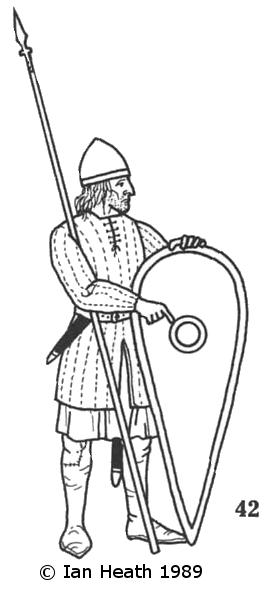 42. ROUTIER, 12th CENTURY
42. ROUTIER, 12th CENTURYThe 12th century saw the evolution of free lance mercenary companies on the Continent, composed of professional soldiers prepared to hire themselves out to the highest bidder. These companies, or 'bands', were variously called routes, ruttae, rota or rotten, and their members were therefore called routiers or ruterii. They were also known as brigans, ribauds, ravagers, paillers (or palearii, 'strawmen', for reasons now unknown), cultelarii (from cultellus, a knife) and cothrelli, coterelli or cotereaux (from coterel, a small haubergeon). Other descriptive terms used for them in contemporary sources give us a good idea of their principal recruiting grounds: Aragonese, Navarrese, Catalans, Basques, Hainaulters, Brabanšons, Triaverdins (from Trier), Mainades (from Maine?) and Germans. One routier commander in France even had an Arabic name, Curbaran, which may indicate he was an Andalusian exile or a Mozarab.
Walter Map, an Anglo-Norman writing c.1180, described such mercenaries as 'forming bands of up to 1,000 men', each of them 'protected from head to foot by a leather jerkin [ie, a gambeson] and ... armed with steel, staves and iron.' He concludes: 'This movement arose in Brabant, hence the name Brabanšons.' Others describe them as armed with whatever weapons they could lay their hands on and 'fierce for plunder and fearless of death, cutting the throats of any who stood in their way'. In fact one gets a distinct impression from the sources that many routiers were little better than armed peasants and behaved accordingly.
In 1179 the employment of such troops was ineffectually condemned by a Lateran Council, since they allegedly had no respect for Church property or the age or sex of their victims. Their numbers dwindled after the end of the 12th century, though ironically - considering the papal ban on hiring them - many participated in the bloody Albigensian Crusade of 1208-29 against the county of Toulouse.
[Based on Gualteri Mapes. De nugis curialium distinctiones quinque]
